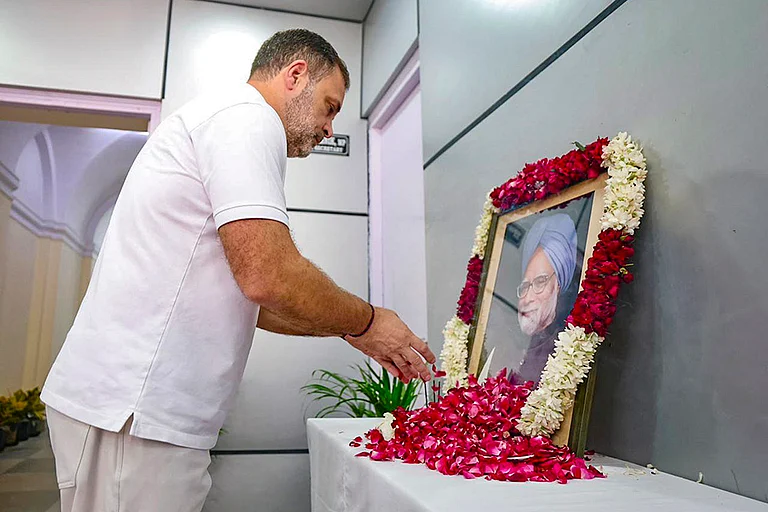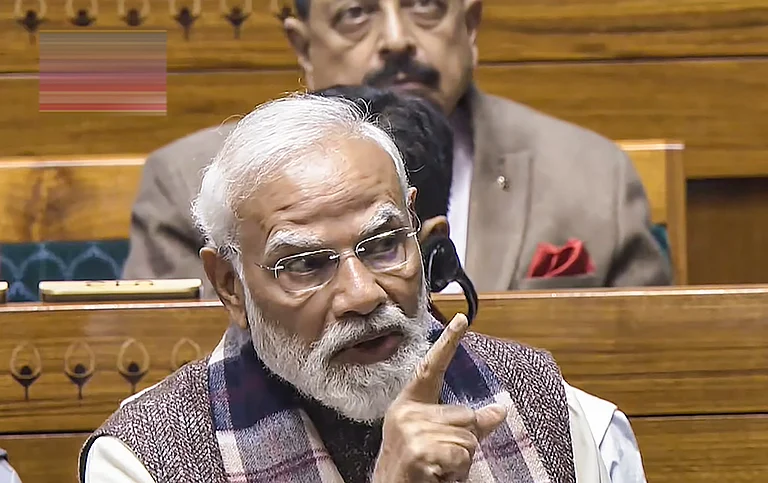
A high-pitched battle awaits as we inch closer to the 2024 Lok Sabha election scheduled to be held in seven phases from April 19 to June 1. The last five years, BJP-led National Democratic Alliance's second term, saw a series of civil protests, political cross-firings and constitutional debates. At Outlook, we are closely tracking the developments and bringing to you exclusive stories, ground reports and in-depth analysis of the state-wise electoral scenario, focusing on regional parties, their journeys in recent years and how it will play out at a national level.
Today, we are looking at Uttar Pradesh, one of the most electorally significant states, contributing the highest number of MPs (80) to the Lok Sabha. The incumbent BJP will be looking to replicate its 2019 sweep when the saffron party secured 62 seats and the NDA 64. The SP-Congress alliance under the INDIA bloc banner, which could only be formulated last minute, will be looking to inflict maximum damage with their forces now combined.
The battle for Uttar Pradesh has heated up with Prime Minister Narendra Modi himself canvassing parts of western UP where voting is set to take place in the first phase of Lok Sabha elections on April 19. The PM, who is contesting from the Varanasi seat, held roadshows and rallies in Ghaziabad, Sharanpur. Before that, he had addressed crowds at a massive gathering in Meerut. Chief Minister Yogi Adityanath has also been at his side. Uttar Pradesh’s electoral importance is underscored by the fact that it sends 80 MPs to Parliament, the highest across the nation. But the electoral importance of the state is not in just the numbers. UP is the ideological home ground of the Bhartiya Janta Party where a majority of its socio-political politics has been centred. It is the heart of The Hindu heartland and has sent several political stalwarts to the centre from across party lines. Known for its caste-based politics, ‘Ganga-Jamuni’ tehzeeb, home to several social justice movements as well as Hindutva laboratory, Uttar Pradesh has been under the rule of BJP since 2017 when Adityanath took over as Chief Minister and remained so after the 2022 Assembly Elections. Ahead of the Lok Sabha polls, the BJP is hoping to maintain its sway in the state where the party has high ground level support. But all may not be as smooth sailing for the party as might appear.
Meanwhile, Opposition parties including regional satraps like the Samajwadi Party and its alliance partner Congress, have the herculean task of unseating the ruling party. Here’s a brief look at some of the major poll planks shaping elections this year and the issues parties will be facing in the upcoming Lok Sabha elections in UP:
Majoritarian Politics
The inauguration of the Ram Temple marked the merger of religion and state and was seen by many as the culmination of long years of Hindutva mobilisation. Other similar land disputes between religious communities over a place of worship in Varanasi (Kashi) and Mathura have found a new thrust with fresh judgments and court orders. The strategic relaunch of the contentious Citizenship Amendment Act (2019) which critics claim is anti-minority, has also been seen by many political commentators as a means to channelise nationalistic and majoritarian sentiment to sway the dominant community’s votes in the upcoming polls. Incidentally, the notification of CAA coincided with the Supreme Court’s electoral bonds verdict. The party has fielded new faces like Saket Mishra, currently a member of the legislative council and son of Ram Mandir construction committee chairman Nripendra Mishra, from Shravasti seat. Others involved with Ram janmabhoomi movement like Lallu Singh, Sakshi Maharaj, Sadhvi Jyoti along with actor Arun Govil who portrayed the role of Ram in Ramayana, have also got tickets, indicating the party’s interest in keeping the mandir-momentum alive.
Beyond the Hindutva strategy, the BJP also needs to secure the votes of the OBC and SC communities which have erstwhile voted for caste-based parties like Samajwadi Party or Bahujan Samaj Party. The SP losing out on its traditional M-Y vote-bank and a waning BSP have left these pools of voters with new choices and 2019 Lok Sabha as well as 2022 legislative assembly elections showed that many voted for the BJP.
Social engineering: The OBC factor
The focus on social engineering is evident in last week’s reshuffle when two OBC faces - Om Prakash Rajbhar, president of the Suheldev Bharatiya Samaj Party and Noniya Chauhan, were inducted into the Adityanath cabinet.
The party’s decision to pick a second OBC leader - Nayab Singh Saini - to join its rank of 12 chief ministers marks its determined push to consolidate the community's votes and blunt the opposition's attempt to weaken its support base ahead of Lok Sabha polls. Saini was named Haryana CM, three months after the BJP made the surprise pick of Mohan Yadav to replace another Other Backward Classes (OBC) leader Shivraj Singh Chouhan as Madhya Pradesh chief minister. The move aligns with a trend that has accelerated within the BJP following aggressive efforts by the Congress and its allies, such as the Samajwadi Party in Uttar Pradesh and the RJD in Bihar, to attract the OBCs - the largest and politically influential demographic, especially in Hindi speaking states.
There has also been a shift in the BJP’s traditional approach toward caste engineering which centred around the consolidation of Yadav and non-Yadav votes. The replacement of Shiv Raj Chouhan who also hails from a backward community with Mohan Yadav was seen as strategic for UP since the latter belongs to a caste that is predominant in the states of Uttar Pradesh and Bihar. These states collectively hold 120 Lok Sabha seats and witnessed a sweeping victory for the BJP and its allies in the 2019 Lok Sabha polls. Yadavs have a sizeable presence in many other states as well. In 2019, the BSP-SP-RLD combine dealt a blow to the BJP in some seats, though it failed to change the overall performance of the party. This time, BSP is fighting on its own. Analysts like Manidra N Jha feel that the Mayawati-led party is laying low on purpose with the exception that the BJP will allow it more room during the next legislative assembly election. RLD is also a BJP ally this time.
Welfare sops and incentive politics
Apart from vote banks based on religious and caste identities, BJP has also managed to create a massive bank of beneficiaries which receive the benefits of the developmental and welfare schemes that the Modi government has brought in the last decade. These beneficiaries or ‘labharthi’ have been a constant focus of the BJP with schemes like free ration, free treatment and cash transfer to farmers and women during the pandemic which reportedly helped the party surge to a second victory in the state in 2022. That year, BJP claimed that every family received about Rs Rs 3 lakh over the last five years through the medium of various government schemes like PM Awas, PM Kisan, Ujjwala, Mudra loans, Ayushman Bharat, state pension schemes etc.
Ahead of MCC, CM Yogi Adityanath laid foundation stones for projects worth more than Rs.11,000 crore in Lucknow. UP government has announced a 100 percent rebate in electricity bills on tube wells used by farmers with an estimated 14.73 lakh beneficiaries in rural areas and over 5,000 in urban areas.
The same day, the CM also highlighted how the government has distributed Rs 3,500 crore to 15 lakh poor beneficiaries across UP and that 56-lakh people have received free houses under the PM Awaas scheme. Additionally, 15 crore people have benefited from the free ration facility, Yogi added.
Congress’s Bharat Jodo Yatra, SP Alliance
INDIA alliance bloc partners SP and Congress have arrived at a seat sharing formula with the latter contesting over 17 seats while the Akhilesh Yadav-led SP and its smaller allies will be fighting over 63 seats. Unlike 2017 when the SP-Congress alliance failed to materialise in time, both parties sealed the deal in the end of February amid high speculation over Congress’ share (initially projected to be 11 seats) and RLD flip. However, lack of cohesion between both parties including ground workers and state level party leaders like in 2017 could harm the alliance. As of now, candidates from both parties are carrying out joint exercised to impress a common message and agenda among voters.
Despite the deal, Congress might need more than just a helping hand from SP. Most of the 17 seats on which it is contesting have been under BJP since 2012. In 2019, the Congress lost 15 out of 16 seats contested except Raibareli. The two-month long Baharat Jodo Nyay Yatra passed through several districts of Uttar Pradesh where it was led by Rahul Gandhi. Initially, Gandhi had decided to skip Western UP districts where former ally RLD is strong after the latter’s exit from the INDIA bloc. Observers believe that the loss will be critical for Congress in OBC-dominated seats. Eventually, Gandhi visited western UP districts with considerable Muslim populations and other areas like Hathras and Agra where Jats and Dalits are key electorates. The leader, nevertheless, avoided seats like Baghpat, Mathura, Kairana, Muzaffarnagar, Bijnor, Nagina and Amroha, where the RLD wields influence.
The Congress has denied any connection between the Yatra route changes and the RLD’s exit and refused to call it a sign of “weakness”. Gandhi has nevertheless faced flak for comments he made about the “drunk youth” of Uttar Pradesh. In what appeared to be a veiled jape at PM Modi, Gandhi had said at a rally that he had seen people lying around drunk on the streets of Varanasi, the PM’s constituency.
The party has also sharpened its caste pitch by claiming that no OBC or tribal person attended the Ram Mandir consecration event. The comments were slammed by former Union minister and BJP leader Mani Shankar Prasad who asked Gandhi to “stop attacking the faith of the majority of Indian people and using arrogant language for youth”. Other leaders like Priyanka Gandhi Vadra and senior Congress leaders also attended the rallies. Critics nevertheless feel that the second Yatra failed to spark the public interest like the first Bharat Jodo Yatra and the lack of cohesion or a common identity among INDIA bloc allies has led to further loss of public interest. SP Chief Akhilesh Yadav skipped the Yatra when it reached Raebareily despite reports about a possible visit. Both parties are also facing potential cross-voting by its members. Recent reports suggested that at least 10 SP MLAs in UP have cross voted for BJP candidates.
The 2024 Lok Sabha elections, spread over 44 days, will be held in seven phases from April 19 to June 1, as announced by the Election Commission of India. The results will be declared on June 4.
(With inputs from PTI)





























